Radiation Detection Monitoring And Safety Market Size 2025-2029
The radiation detection monitoring and safety market size is forecast to increase by USD 1.5 billion, at a CAGR of 6.3% between 2024 and 2029.
A primary driver for the global radiation detection monitoring and safety market is the continuous rise in military spending worldwide, which amplifies the need for advanced radiological threat detection. This is complemented by significant technological advancements in the field, where innovations in radiation detection equipment market are improving precision and responsiveness. These systems are crucial for applications ranging from homeland security to industrial safety. However, the high manufacturing cost of radiation detection, monitoring, and safety devices, including specialized x-ray detector systems, remains a substantial barrier. This financial constraint particularly affects smaller entities and those in developing regions, thereby limiting the broader adoption of these essential safety technologies and impacting the overall market accessibility.The integration of intelligent systems is a key trend, with AI-driven analytics enhancing early anomaly detection and optimizing system performance, a development that is reshaping the non-destructive testing and inspection market. These advancements support a proactive approach to safety by enabling real-time data analysis and predictive maintenance, thereby improving operational efficiency. Despite these innovations, the market's expansion is tempered by the high price of sophisticated equipment. For instance, the capital expenditure for advanced radiotherapy machines can be prohibitive, which is a considerable challenge for healthcare facilities. This cost factor often leads to reliance on older or refurbished equipment, potentially compromising performance and safety standards in critical environments and affecting the alarm monitoring market.
What will be the Size of the Radiation Detection Monitoring And Safety Market during the forecast period?
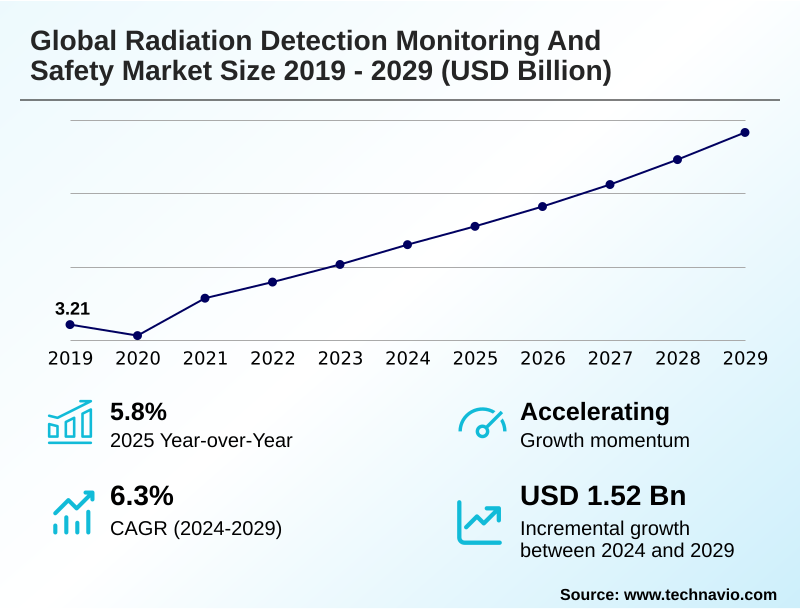
Explore in-depth regional segment analysis with market size data - historical 2019 - 2023 and forecasts 2025-2029 - in the full report.
Request Free Sample
The market's operational landscape is defined by the continuous need for radiation safety compliance and enhanced radiation exposure monitoring. Innovations are focused on developing more sensitive alpha beta gamma detection systems and improving the functionality of personal radiation dosimeters. These advancements are critical for ensuring safety in environments with inherent radiological risks, driving the evolution of monitoring protocols. The emphasis remains on providing reliable and accurate data for both regulatory adherence and operational safety, shaping the development of next-generation radiation measurement instruments.A significant focus within the industry is the development of integrated systems that combine hardware with intelligent software. The adoption of AI and ML in radiation detection algorithms is enhancing the capabilities of systems used in the radiation detection and monitoring equipment market, particularly in real-time anomaly identification and predictive analysis. This shift towards smarter, more autonomous systems is also evident in the x-ray inspection systems technology market, where automated analysis improves throughput and accuracy. These developments are aimed at making safety protocols more proactive and efficient.
How is this Radiation Detection Monitoring And Safety Industry segmented?
The radiation detection monitoring and safety industry research report provides comprehensive data (region-wise segment analysis), with forecasts and estimates in "USD million" for the period 2025-2029, as well as historical data from 2019 - 2023 for the following segments.
- Application
- Healthcare
- Nuclear power plants
- Homeland security and defense
- Industrial applications
- Product
- Detection and monitoring products
- Safety products
- Technology
- Gas-filled detectors
- Scintillators
- Solid-state detectors
- Geography
- North America
- Europe
- Germany
- France
- UK
- Italy
- Spain
- Russia
- APAC
- China
- Japan
- India
- South Korea
- Australia
- Indonesia
- Middle East and Africa
- UAE
- Turkey
- South Africa
- Egypt
- South America
- Rest of World (ROW)
By Application Insights
The healthcare segment is estimated to witness significant growth during the forecast period.
The healthcare segment's activity is closely tied to the integration of radiation-based technologies in diagnostic and therapeutic procedures. Hospitals and diagnostic centers require advanced radiation detection systems to ensure the safety of patients and staff during procedures involving X-rays and radiation therapy. The rising prevalence of chronic diseases, with cancer accounting for a significant portion of new diagnoses annually, drives the demand for radiation-based treatments, necessitating stringent safety protocols and reliable monitoring equipment for effective radiation dose management solution implementation.
Regulatory mandates for personal dosimeters and area monitors are key to maintaining occupational safety standards. The expansion of radiopharmaceutical applications in targeted therapies further increases demand for real-time radiation monitoring. Technological advancements in wearable dosimetry and wireless monitoring are enhancing the efficiency of safety practices. As healthcare providers prioritize both diagnostic efficacy and safety, the role of radiation detection and monitoring, including multiparameter patient monitoring equipment, remains central to operational excellence and compliance in medical institutions.
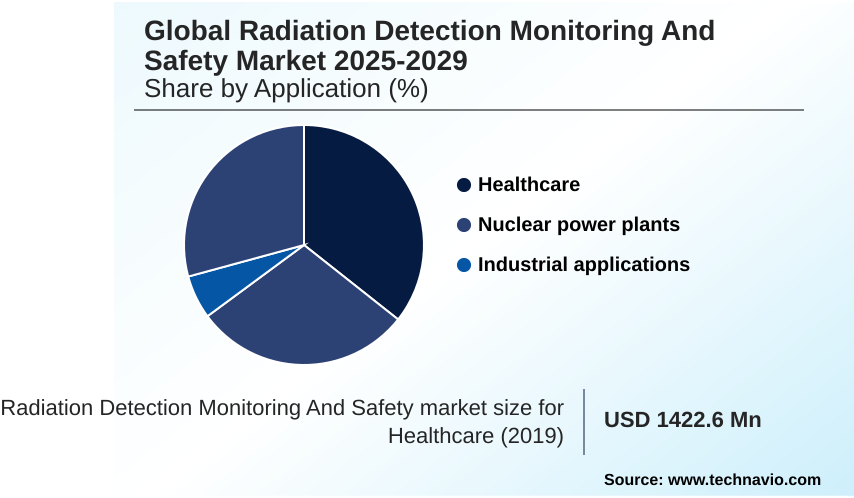
Request Free Sample
The Healthcare segment was valued at USD 1.4 billion in 2019 and showed a gradual increase during the forecast period.
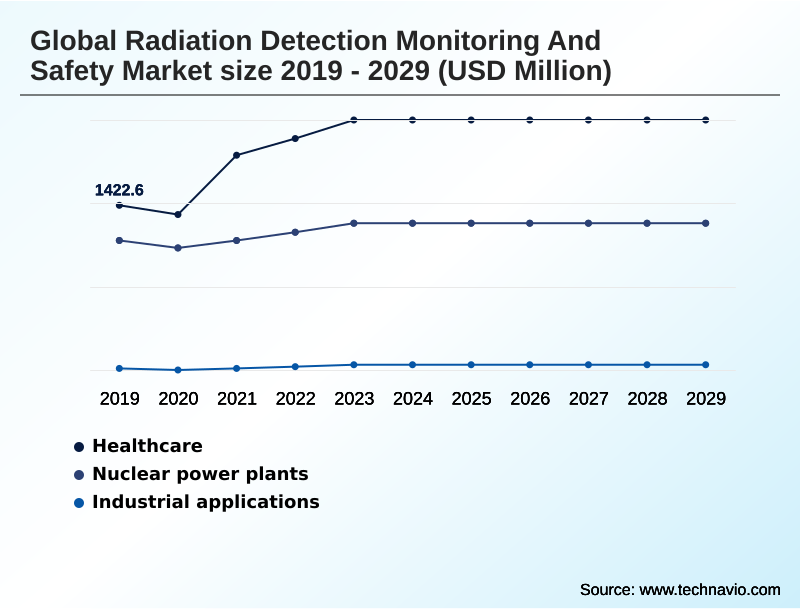
Regional Analysis
North America is estimated to contribute 48.0% to the growth of the global market during the forecast period.Technavio’s analysts have elaborately explained the regional trends and drivers that shape the market during the forecast period.
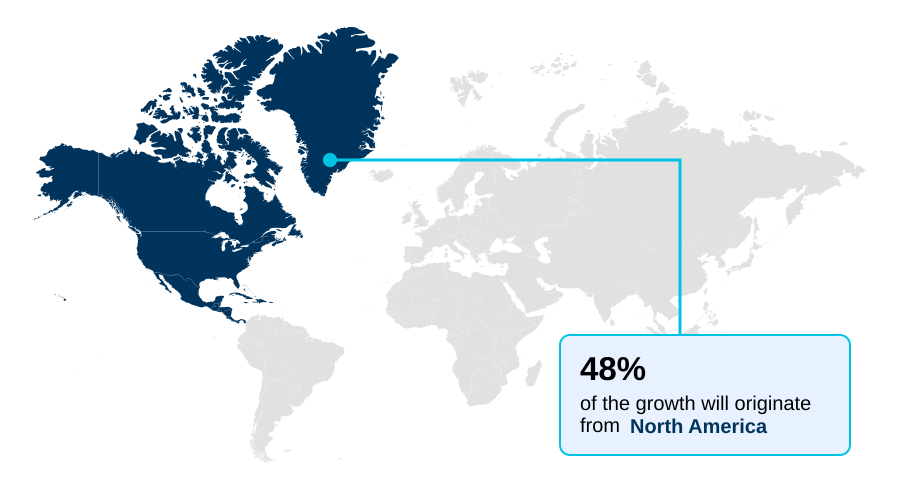
Request Free Sample
The market in North America remains strong, supported by robust regulatory frameworks and consistent investments in nuclear infrastructure, healthcare, and homeland security. The region's emphasis on radiation safety across industrial and medical applications ensures steady demand for advanced detection technologies, including personal radiation dosimeters and real-time radiation monitoring systems. The defense and security sectors, which account for a substantial portion of national budgets, prioritize radiological threat assessment, reinforcing the need for both portable and fixed detection systems.
Commitment to nuclear energy in North America also supports the deployment of comprehensive radiation safety protocols in power plants. The integration of digital technologies and automation in radiation measurement instruments enhances operational efficiency and data accuracy. Research institutions play a critical role in advancing detection technologies like semiconductor detectors. Furthermore, growing awareness of occupational safety standards drives the adoption of personal monitoring devices, ensuring sustained development of the market across the region, where nuclear power provides a notable share of electricity.
Market Dynamics
Our researchers analyzed the data with 2024 as the base year, along with the key drivers, trends, and challenges. A holistic analysis of drivers will help companies refine their marketing strategies to gain a competitive advantage.
The global radiation detection market is experiencing a significant technological shift, driven by OEM investment in R&D. Innovations focus on developing advanced semiconductor materials for radiation detection and achieving cost-effective solid-state detector manufacturing to broaden market access. Key areas of advancement include improving signal-to-noise ratio in scintillators and pioneering high-resolution gamma-ray imaging techniques. The integration of AI-powered anomaly detection in radiation data is revolutionizing monitoring capabilities, while enhancing portable radioisotope identification device performance and deploying drone-based radiological mapping systems expand field applications. For specialized sectors, the development of radiation-hardened components for space applications is critical, and efforts in automated calibration for survey meters are streamlining maintenance and ensuring device accuracy.On the applications front, there's a growing emphasis on personnel and public safety. Systems for real-time personal radiation exposure tracking and wireless dosimetry systems for healthcare workers are becoming standard. For wider security, networked radiation sensor systems for area monitoring are essential for tasks like environmental monitoring near nuclear plants. Public safety measures include integrated radiation detection in security checkpoints and personnel screening for radiological threats. In medical settings, dose management solutions in diagnostic imaging are paramount. Comprehensive safety frameworks are being built, encompassing strict safety protocols for industrial radiography sources, thorough shielding material effectiveness testing, robust training simulation for radiation incident response, and well-defined decontamination procedures for radiological spills.
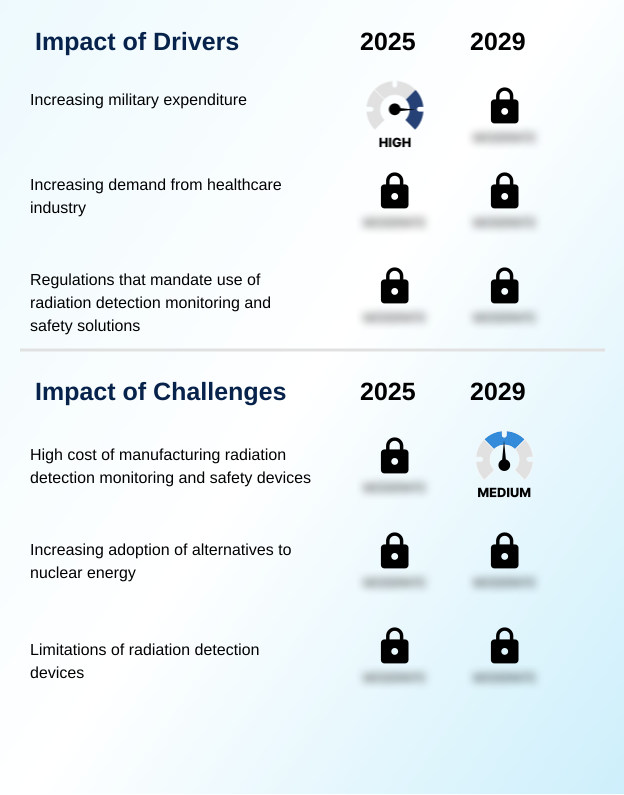
What are the key market drivers leading to the rise in the adoption of Radiation Detection Monitoring And Safety Industry?
- Increasing global military expenditure is a key driver for the global radiation detection monitoring and safety market.
Increasing military expenditure globally is a significant factor influencing the market. Defense spending now constitutes approximately 2.5% of the world's GDP, reflecting a heightened focus on national security and defense capabilities amid geopolitical tensions. This financial commitment translates into greater investment in advanced security technologies, including systems for radiological threat assessment and homeland security radiation detection. The need to equip military and security personnel with reliable radiation portal monitors and portable detection devices to counter potential nuclear or radiological threats underpins demand in this segment, driving continuous innovation in detection and identification technologies.The healthcare industry's expanding reliance on radiation-based technologies for both diagnostics and therapeutics is another primary market driver. The growing prevalence of chronic diseases necessitates the use of advanced medical imaging and radiation therapy, which in turn requires stringent medical radiation safety protocols and dosimetry services. Hospitals and clinics are increasingly investing in real-time radiation monitoring systems and personal radiation dosimeters to ensure patient and staff safety, comply with regulatory standards, and optimize radiation dose management. This demand creates a stable and growing segment for radiation safety products and services.
What are the market trends shaping the Radiation Detection Monitoring And Safety Industry?
- Technological advancements are fundamentally enhancing the capabilities and applications within the radiation detection sector.
The market is experiencing notable growth due to continuous technological advancements across key end-user sectors. As industries such as healthcare, nuclear energy, and homeland security elevate their focus on radiation safety, the need for advanced detection technologies like improved alpha beta gamma detection systems is expanding. This evolution is supported by stricter regulatory frameworks and a greater understanding of radiation risks, compelling organizations to invest in more sophisticated and reliable safety solutions. The shift is away from traditional detection methods toward intelligent, automated systems, including those used in the radiation detection and monitoring equipment market, that offer superior performance and compliance, fostering new opportunities across the value chain.The integration of artificial intelligence and machine learning is significantly enhancing the capabilities of radiation detection systems. AI-powered systems analyze vast datasets in real time, improving the precision of real-time radiation monitoring and enabling early detection of anomalies for better operational safety. Meanwhile, ML algorithms are being used to optimize system performance and reduce false alarms from devices in the explosive detection equipment market, boosting user confidence. These technological integrations are not only expanding the range of applications for radiation detection monitoring and safety solutions but also making them more accessible and adaptable to diverse operational settings, including for home-care monitoring and diagnostics.
What challenges does the Radiation Detection Monitoring And Safety Industry face during its growth?
- The high cost associated with manufacturing sophisticated radiation detection, monitoring, and safety devices presents a significant challenge to market growth.
The significant upfront investment required for radiation detection, monitoring, and safety devices acts as a considerable restraint on market growth. The price for a single unit can range from USD 11,000 to USD 18,000, representing a substantial capital expenditure for many organizations. This high cost is a barrier to adoption for smaller institutions and facilities, particularly in developing regions, which limits market penetration. The financial burden effectively makes advanced radiation spectroscopy systems and contamination monitoring instruments inaccessible to a portion of potential end-users, forcing them to delay upgrades or seek less effective alternatives.In addition to initial hardware costs, the total cost of ownership is elevated by ongoing operational expenses. These include regular maintenance, dosimetry services, and the necessity of employing and training skilled personnel to operate the equipment and accurately interpret data. In specialized fields like healthcare, the costs are even higher, with certain radiation therapy machines requiring millions in investment. Consequently, some end-users opt for refurbished equipment to manage costs, which can introduce risks related to performance and longevity. These cumulative expenses underscore the financial constraints that temper the adoption of critical safety technologies.
Exclusive Customer Landscape
The radiation detection monitoring and safety market forecasting report includes the adoption lifecycle of the market, covering from the innovator’s stage to the laggard’s stage. It focuses on adoption rates in different regions based on penetration. Furthermore, the radiation detection monitoring and safety market report also includes key purchase criteria and drivers of price sensitivity to help companies evaluate and develop their market growth analysis strategies.
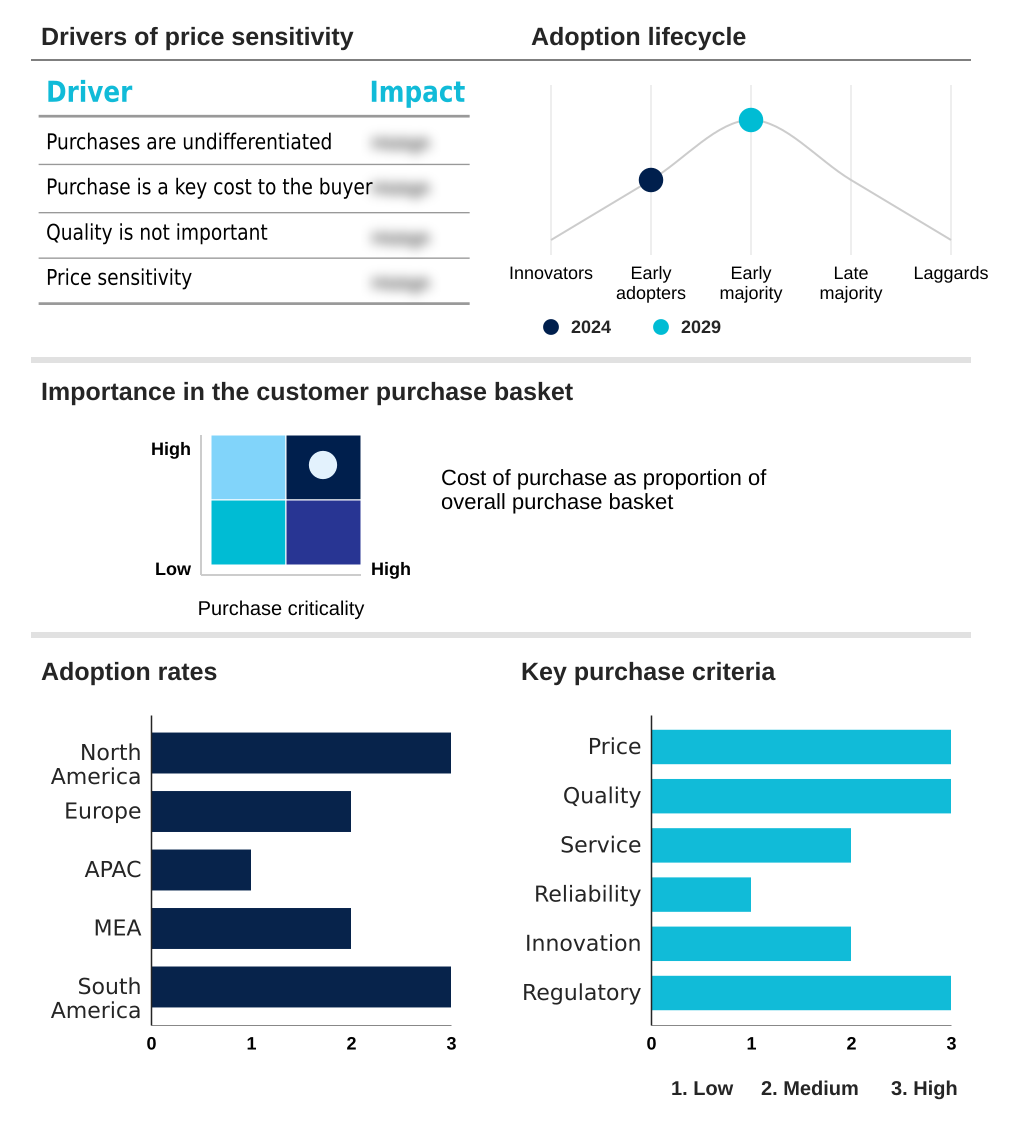
Customer Landscape
Key Companies & Market Insights
Companies are implementing various strategies, such as strategic alliances, radiation detection monitoring and safety market forecast, partnerships, mergers and acquisitions, geographical expansion, and product/service launches, to enhance their presence in the industry.
Amray Medical - The company provides comprehensive radiation safety technology and compliance solutions, including advanced dosimetry services. These services are designed for comprehensive radiation dose monitoring, which helps ensure the safety of personnel working across various sectors such as healthcare and industrial environments, where exposure to radiation is a potential risk.
The industry research and growth report includes detailed analyses of the competitive landscape of the market and information about key companies, including:
- Amray Medical
- Arktis Radiation Detectors Ltd.
- Baker Hughes Co.
- Centronic Ltd.
- ECOTEST
- Fuji Electric Co. Ltd.
- Honeywell International Inc.
- International Medcom Inc.
- John Caunt Scientific Ltd.
- LANDAUER
- Ludlum Measurements Inc.
- Mirion Technologies Inc.
- ORTEC
- Rapiscan Systems Inc.
- S.E. International Inc.
- Teledyne Technologies Inc.
- Thermo Fisher Scientific Inc.
- UAB Polimaster Europe
- Unfors RaySafe AB
Qualitative and quantitative analysis of companies has been conducted to help clients understand the wider business environment as well as the strengths and weaknesses of key industry players. Data is qualitatively analyzed to categorize companies as pure play, category-focused, industry-focused, and diversified; it is quantitatively analyzed to categorize companies as dominant, leading, strong, tentative, and weak.
Recent Development and News in Radiation Detection Monitoring And Safety Market
In April 2024, Mirion Technologies Inc. launched the new Mirion Connect platform, a cloud-based software solution designed to centralize data from its portfolio of radiation detection and measurement instruments, enhancing real-time monitoring and data management capabilities for customers in nuclear, defense, and medical sectors.In February 2024, Thermo Fisher Scientific Inc. announced the release of its next-generation RadEye X-Series handheld radiation detectors, featuring improved ergonomics, a larger display, and enhanced connectivity options for faster and more accurate radiological surveying and threat detection.In May 2024, Teledyne FLIR Defense, part of Teledyne Technologies Inc., was awarded a contract to supply its R80D SkyRaider drones equipped with radiological and nuclear reconnaissance payloads to an allied military force, enhancing their CBRN defense capabilities.
Research Analyst Overview
The global radiation detection monitoring and safety market is defined by its critical role in safeguarding personnel and environments across multiple sectors. The continuous process of radiation exposure monitoring relies on an evolving suite of radiation measurement instruments, including personal radiation dosimeters and area radiation monitors, which are integral to nuclear facility safety, medical radiation safety, and industrial radiography safety. Core practices involve the use of handheld survey meters and contamination monitoring instruments for environmental radiation surveillance and immediate ionizing particle detection. The provision of dosimetry services, utilizing technologies like thermoluminescent dosimeters (TLDS) and optically stimulated luminescence (OSL), is coupled with stringent radiation dosimetry calibration and the deployment of appropriate radiation protection equipment to ensure comprehensive safety protocols are maintained.Technological progression is evident in the sophistication of detection systems, with the overall global radiation detection monitoring and safety market expected to show an expansion of over 6% in the next year. Advanced instruments increasingly incorporate capabilities for alpha beta gamma detection and specialized neutron detection systems. For security applications, radiation portal monitors are essential for homeland security radiation detection, complementing efforts in radiological threat assessment. The underlying technology, from Geiger-Muller tubes to advanced scintillation detectors and solid-state radiation detectors like semiconductor detectors, improves nuclear material identification. This is supported by radiation spectroscopy systems and radioisotope identification devices, while emergency radiation response planning integrates radiation safety training, radiation shielding design, gamma imaging systems, and radiation tolerant electronics, reinforcing radiation safety compliance.
Dive into Technavio’s robust research methodology, blending expert interviews, extensive data synthesis, and validated models for unparalleled Radiation Detection Monitoring And Safety Market insights. See full methodology.
|
Market Scope
|
|
Report Coverage
|
Details
|
|
Page number
|
289
|
|
Base year
|
2024
|
|
Historic period
|
2019 - 2023 |
|
Forecast period
|
2025-2029
|
|
Growth momentum & CAGR
|
Accelerating at a CAGR of 6.3%
|
|
Market growth 2024-2029
|
USD 1.5 billion
|
|
Market structure
|
Fragmented
|
|
YoY growth 2024-2029(%)
|
5.8%
|
|
Key countries
|
US, Canada, Mexico, Germany, France, UK, Italy, Spain, Russia, China, Japan, India, South Korea, Australia, Indonesia, Saudi Arabia, UAE, Turkey, South Africa, Egypt, Brazil, Argentina, Colombia
|
|
Competitive landscape
|
Leading Companies, Market Positioning of Companies, Competitive Strategies, and Industry Risks
|
Request Free Sample
What are the Key Data Covered in this Radiation Detection Monitoring And Safety Market Research and Growth Report?
- CAGR of the Radiation Detection Monitoring And Safety industry during the forecast period
- Detailed information on factors that will drive the growth and forecasting between 2024 and 2029
- Precise estimation of the size of the market and its contribution of the industry in focus to the parent market
- Accurate predictions about upcoming growth and trends and changes in consumer behaviour
- Growth of the market across North America, Europe, APAC, Middle East and Africa, South America
- Thorough analysis of the market’s competitive landscape and detailed information about companies
- Comprehensive analysis of factors that will challenge the radiation detection monitoring and safety market growth of industry companies
We can help! Our analysts can customize this radiation detection monitoring and safety market research report to meet your requirements.
Get in touch
1 Executive Summary
- 1 Executive Summary
- 1.1 Market overview
- Executive Summary - Chart on Market Overview
- Executive Summary - Data Table on Market Overview
- Executive Summary - Chart on Global Market Characteristics
- Executive Summary - Chart on Market by Geography
- Executive Summary - Chart on Market Segmentation by Application
- Executive Summary - Chart on Market Segmentation by Product
- Executive Summary - Chart on Market Segmentation by Technology
- Executive Summary - Chart on Incremental Growth
- Executive Summary - Data Table on Incremental Growth
- Executive Summary - Chart on Company Market Positioning
2 Technavio Analysis
- 2 Technavio Analysis
- 2.1 Analysis of price sensitivity, lifecycle, customer purchase basket, adoption rates, and purchase criteria
- Analysis of price sensitivity, lifecycle, customer purchase basket, adoption rates, and purchase criteria
- 2.2 Criticality of inputs and Factors of differentiation
- Chart on Overview on criticality of inputs and factors of differentiation
- 2.3 Factors of disruption
- Chart on Overview on factors of disruption
- 2.4 Impact of drivers and challenges
- Chart on Impact of drivers and challenges in 2024 and 2029
3 Market Landscape
- 3 Market Landscape
- 3.1 Market ecosystem
- Chart on Parent Market
- Data Table on - Parent Market
- 3.2 Market characteristics
- Chart on Market characteristics analysis
- 3.3 Value chain analysis
- Chart on Value chain analysis
4 Market Sizing
- 4 Market Sizing
- 4.1 Market definition
- Data Table on Offerings of companies included in the market definition
- 4.2 Market segment analysis
- 4.3 Market size 2024
- 4.4 Market outlook: Forecast for 2024-2029
- Chart on Global - Market size and forecast 2024-2029 ($ billion)
- Data Table on Global - Market size and forecast 2024-2029 ($ billion)
- Chart on Global Market: Year-over-year growth 2024-2029 (%)
- Data Table on Global Market: Year-over-year growth 2024-2029 (%)
5 Historic Market Size
- 5 Historic Market Size
- 5.1 Global Radiation Detection Monitoring And Safety Market 2019 - 2023
- Historic Market Size - Data Table on Global Radiation Detection Monitoring And Safety Market 2019 - 2023 ($ billion)
- 5.2 Application segment analysis 2019 - 2023
- Historic Market Size - Application Segment 2019 - 2023 ($ billion)
- 5.3 Product segment analysis 2019 - 2023
- Historic Market Size - Product Segment 2019 - 2023 ($ billion)
- 5.4 Technology segment analysis 2019 - 2023
- Historic Market Size - Technology Segment 2019 - 2023 ($ billion)
- 5.5 Geography segment analysis 2019 - 2023
- Historic Market Size - Geography Segment 2019 - 2023 ($ billion)
- 5.6 Country segment analysis 2019 - 2023
- Historic Market Size - Country Segment 2019 - 2023 ($ billion)
6 Qualitative Analysis
- 6 Qualitative Analysis
- 6.1 Impact of AI on the Global Radiation Detection Monitoring and Safety Market
7 Five Forces Analysis
- 7 Five Forces Analysis
- 7.1 Five forces summary
- Five forces analysis - Comparison between 2024 and 2029
- 7.2 Bargaining power of buyers
- Bargaining power of buyers - Impact of key factors 2024 and 2029
- 7.3 Bargaining power of suppliers
- Bargaining power of suppliers - Impact of key factors in 2024 and 2029
- 7.4 Threat of new entrants
- Threat of new entrants - Impact of key factors in 2024 and 2029
- 7.5 Threat of substitutes
- Threat of substitutes - Impact of key factors in 2024 and 2029
- 7.6 Threat of rivalry
- Threat of rivalry - Impact of key factors in 2024 and 2029
- 7.7 Market condition
- Chart on Market condition - Five forces 2024 and 2029
8 Market Segmentation by Application
- 8 Market Segmentation by Application
- 8.1 Market segments
- Chart on Application - Market share 2024-2029 (%)
- Data Table on Application - Market share 2024-2029 (%)
- 8.2 Comparison by Application
- Chart on Comparison by Application
- Data Table on Comparison by Application
- 8.3 Healthcare - Market size and forecast 2024-2029
- Chart on Healthcare - Market size and forecast 2024-2029 ($ billion)
- Data Table on Healthcare - Market size and forecast 2024-2029 ($ billion)
- Chart on Healthcare - Year-over-year growth 2024-2029 (%)
- Data Table on Healthcare - Year-over-year growth 2024-2029 (%)
- 8.4 Nuclear power plants - Market size and forecast 2024-2029
- Chart on Nuclear power plants - Market size and forecast 2024-2029 ($ billion)
- Data Table on Nuclear power plants - Market size and forecast 2024-2029 ($ billion)
- Chart on Nuclear power plants - Year-over-year growth 2024-2029 (%)
- Data Table on Nuclear power plants - Year-over-year growth 2024-2029 (%)
- 8.5 Homeland security and defense - Market size and forecast 2024-2029
- Chart on Homeland security and defense - Market size and forecast 2024-2029 ($ billion)
- Data Table on Homeland security and defense - Market size and forecast 2024-2029 ($ billion)
- Chart on Homeland security and defense - Year-over-year growth 2024-2029 (%)
- Data Table on Homeland security and defense - Year-over-year growth 2024-2029 (%)
- 8.6 Industrial applications - Market size and forecast 2024-2029
- Chart on Industrial applications - Market size and forecast 2024-2029 ($ billion)
- Data Table on Industrial applications - Market size and forecast 2024-2029 ($ billion)
- Chart on Industrial applications - Year-over-year growth 2024-2029 (%)
- Data Table on Industrial applications - Year-over-year growth 2024-2029 (%)
- 8.7 Market opportunity by Application
- Market opportunity by Application ($ billion)
- Data Table on Market opportunity by Application ($ billion)
9 Market Segmentation by Product
- 9 Market Segmentation by Product
- 9.1 Market segments
- Chart on Product - Market share 2024-2029 (%)
- Data Table on Product - Market share 2024-2029 (%)
- 9.2 Comparison by Product
- Chart on Comparison by Product
- Data Table on Comparison by Product
- 9.3 Detection and monitoring products - Market size and forecast 2024-2029
- Chart on Detection and monitoring products - Market size and forecast 2024-2029 ($ billion)
- Data Table on Detection and monitoring products - Market size and forecast 2024-2029 ($ billion)
- Chart on Detection and monitoring products - Year-over-year growth 2024-2029 (%)
- Data Table on Detection and monitoring products - Year-over-year growth 2024-2029 (%)
- 9.4 Safety products - Market size and forecast 2024-2029
- Chart on Safety products - Market size and forecast 2024-2029 ($ billion)
- Data Table on Safety products - Market size and forecast 2024-2029 ($ billion)
- Chart on Safety products - Year-over-year growth 2024-2029 (%)
- Data Table on Safety products - Year-over-year growth 2024-2029 (%)
- 9.5 Market opportunity by Product
- Market opportunity by Product ($ billion)
- Data Table on Market opportunity by Product ($ billion)
10 Market Segmentation by Technology
- 10 Market Segmentation by Technology
- 10.1 Market segments
- Chart on Technology - Market share 2024-2029 (%)
- Data Table on Technology - Market share 2024-2029 (%)
- 10.2 Comparison by Technology
- Chart on Comparison by Technology
- Data Table on Comparison by Technology
- 10.3 Gas-filled detectors - Market size and forecast 2024-2029
- Chart on Gas-filled detectors - Market size and forecast 2024-2029 ($ billion)
- Data Table on Gas-filled detectors - Market size and forecast 2024-2029 ($ billion)
- Chart on Gas-filled detectors - Year-over-year growth 2024-2029 (%)
- Data Table on Gas-filled detectors - Year-over-year growth 2024-2029 (%)
- 10.4 Scintillators - Market size and forecast 2024-2029
- Chart on Scintillators - Market size and forecast 2024-2029 ($ billion)
- Data Table on Scintillators - Market size and forecast 2024-2029 ($ billion)
- Chart on Scintillators - Year-over-year growth 2024-2029 (%)
- Data Table on Scintillators - Year-over-year growth 2024-2029 (%)
- 10.5 Solid-state detectors - Market size and forecast 2024-2029
- Chart on Solid-state detectors - Market size and forecast 2024-2029 ($ billion)
- Data Table on Solid-state detectors - Market size and forecast 2024-2029 ($ billion)
- Chart on Solid-state detectors - Year-over-year growth 2024-2029 (%)
- Data Table on Solid-state detectors - Year-over-year growth 2024-2029 (%)
- 10.6 Market opportunity by Technology
- Market opportunity by Technology ($ billion)
- Data Table on Market opportunity by Technology ($ billion)
11 Customer Landscape
- 11 Customer Landscape
- 11.1 Customer landscape overview
- Analysis of price sensitivity, lifecycle, customer purchase basket, adoption rates, and purchase criteria
12 Geographic Landscape
- 12 Geographic Landscape
- 12.1 Geographic segmentation
- Chart on Market share by geography 2024-2029 (%)
- Data Table on Market share by geography 2024-2029 (%)
- 12.2 Geographic comparison
- Chart on Geographic comparison
- Data Table on Geographic comparison
- 12.3 North America - Market size and forecast 2024-2029
- Chart on North America - Market size and forecast 2024-2029 ($ billion)
- Data Table on North America - Market size and forecast 2024-2029 ($ billion)
- Chart on North America - Year-over-year growth 2024-2029 (%)
- Data Table on North America - Year-over-year growth 2024-2029 (%)
- Chart on Regional Comparison - North America
- Data Table on Regional Comparison - North America
- 12.3.1 US - Market size and forecast 2024-2029
- Chart on US - Market size and forecast 2024-2029 ($ billion)
- Data Table on US - Market size and forecast 2024-2029 ($ billion)
- Chart on US - Year-over-year growth 2024-2029 (%)
- Data Table on US - Year-over-year growth 2024-2029 (%)
- 12.3.2 Canada - Market size and forecast 2024-2029
- Chart on Canada - Market size and forecast 2024-2029 ($ billion)
- Data Table on Canada - Market size and forecast 2024-2029 ($ billion)
- Chart on Canada - Year-over-year growth 2024-2029 (%)
- Data Table on Canada - Year-over-year growth 2024-2029 (%)
- 12.3.3 Mexico - Market size and forecast 2024-2029
- Chart on Mexico - Market size and forecast 2024-2029 ($ billion)
- Data Table on Mexico - Market size and forecast 2024-2029 ($ billion)
- Chart on Mexico - Year-over-year growth 2024-2029 (%)
- Data Table on Mexico - Year-over-year growth 2024-2029 (%)
- 12.4 Europe - Market size and forecast 2024-2029
- Chart on Europe - Market size and forecast 2024-2029 ($ billion)
- Data Table on Europe - Market size and forecast 2024-2029 ($ billion)
- Chart on Europe - Year-over-year growth 2024-2029 (%)
- Data Table on Europe - Year-over-year growth 2024-2029 (%)
- Chart on Regional Comparison - Europe
- Data Table on Regional Comparison - Europe
- 12.4.1 Germany - Market size and forecast 2024-2029
- Chart on Germany - Market size and forecast 2024-2029 ($ billion)
- Data Table on Germany - Market size and forecast 2024-2029 ($ billion)
- Chart on Germany - Year-over-year growth 2024-2029 (%)
- Data Table on Germany - Year-over-year growth 2024-2029 (%)
- 12.4.2 France - Market size and forecast 2024-2029
- Chart on France - Market size and forecast 2024-2029 ($ billion)
- Data Table on France - Market size and forecast 2024-2029 ($ billion)
- Chart on France - Year-over-year growth 2024-2029 (%)
- Data Table on France - Year-over-year growth 2024-2029 (%)
- 12.4.3 UK - Market size and forecast 2024-2029
- Chart on UK - Market size and forecast 2024-2029 ($ billion)
- Data Table on UK - Market size and forecast 2024-2029 ($ billion)
- Chart on UK - Year-over-year growth 2024-2029 (%)
- Data Table on UK - Year-over-year growth 2024-2029 (%)
- 12.4.4 Italy - Market size and forecast 2024-2029
- Chart on Italy - Market size and forecast 2024-2029 ($ billion)
- Data Table on Italy - Market size and forecast 2024-2029 ($ billion)
- Chart on Italy - Year-over-year growth 2024-2029 (%)
- Data Table on Italy - Year-over-year growth 2024-2029 (%)
- 12.4.5 Spain - Market size and forecast 2024-2029
- Chart on Spain - Market size and forecast 2024-2029 ($ billion)
- Data Table on Spain - Market size and forecast 2024-2029 ($ billion)
- Chart on Spain - Year-over-year growth 2024-2029 (%)
- Data Table on Spain - Year-over-year growth 2024-2029 (%)
- 12.4.6 Russia - Market size and forecast 2024-2029
- Chart on Russia - Market size and forecast 2024-2029 ($ billion)
- Data Table on Russia - Market size and forecast 2024-2029 ($ billion)
- Chart on Russia - Year-over-year growth 2024-2029 (%)
- Data Table on Russia - Year-over-year growth 2024-2029 (%)
- 12.5 APAC - Market size and forecast 2024-2029
- Chart on APAC - Market size and forecast 2024-2029 ($ billion)
- Data Table on APAC - Market size and forecast 2024-2029 ($ billion)
- Chart on APAC - Year-over-year growth 2024-2029 (%)
- Data Table on APAC - Year-over-year growth 2024-2029 (%)
- Chart on Regional Comparison - APAC
- Data Table on Regional Comparison - APAC
- 12.5.1 China - Market size and forecast 2024-2029
- Chart on China - Market size and forecast 2024-2029 ($ billion)
- Data Table on China - Market size and forecast 2024-2029 ($ billion)
- Chart on China - Year-over-year growth 2024-2029 (%)
- Data Table on China - Year-over-year growth 2024-2029 (%)
- 12.5.2 Japan - Market size and forecast 2024-2029
- Chart on Japan - Market size and forecast 2024-2029 ($ billion)
- Data Table on Japan - Market size and forecast 2024-2029 ($ billion)
- Chart on Japan - Year-over-year growth 2024-2029 (%)
- Data Table on Japan - Year-over-year growth 2024-2029 (%)
- 12.5.3 India - Market size and forecast 2024-2029
- Chart on India - Market size and forecast 2024-2029 ($ billion)
- Data Table on India - Market size and forecast 2024-2029 ($ billion)
- Chart on India - Year-over-year growth 2024-2029 (%)
- Data Table on India - Year-over-year growth 2024-2029 (%)
- 12.5.4 South Korea - Market size and forecast 2024-2029
- Chart on South Korea - Market size and forecast 2024-2029 ($ billion)
- Data Table on South Korea - Market size and forecast 2024-2029 ($ billion)
- Chart on South Korea - Year-over-year growth 2024-2029 (%)
- Data Table on South Korea - Year-over-year growth 2024-2029 (%)
- 12.5.5 Australia - Market size and forecast 2024-2029
- Chart on Australia - Market size and forecast 2024-2029 ($ billion)
- Data Table on Australia - Market size and forecast 2024-2029 ($ billion)
- Chart on Australia - Year-over-year growth 2024-2029 (%)
- Data Table on Australia - Year-over-year growth 2024-2029 (%)
- 12.5.6 Indonesia - Market size and forecast 2024-2029
- Chart on Indonesia - Market size and forecast 2024-2029 ($ billion)
- Data Table on Indonesia - Market size and forecast 2024-2029 ($ billion)
- Chart on Indonesia - Year-over-year growth 2024-2029 (%)
- Data Table on Indonesia - Year-over-year growth 2024-2029 (%)
- 12.6 Middle East and Africa - Market size and forecast 2024-2029
- Chart on Middle East and Africa - Market size and forecast 2024-2029 ($ billion)
- Data Table on Middle East and Africa - Market size and forecast 2024-2029 ($ billion)
- Chart on Middle East and Africa - Year-over-year growth 2024-2029 (%)
- Data Table on Middle East and Africa - Year-over-year growth 2024-2029 (%)
- Chart on Regional Comparison - Middle East and Africa
- Data Table on Regional Comparison - Middle East and Africa
- 12.6.1 Saudi Arabia - Market size and forecast 2024-2029
- Chart on Saudi Arabia - Market size and forecast 2024-2029 ($ billion)
- Data Table on Saudi Arabia - Market size and forecast 2024-2029 ($ billion)
- Chart on Saudi Arabia - Year-over-year growth 2024-2029 (%)
- Data Table on Saudi Arabia - Year-over-year growth 2024-2029 (%)
- 12.6.2 UAE - Market size and forecast 2024-2029
- Chart on UAE - Market size and forecast 2024-2029 ($ billion)
- Data Table on UAE - Market size and forecast 2024-2029 ($ billion)
- Chart on UAE - Year-over-year growth 2024-2029 (%)
- Data Table on UAE - Year-over-year growth 2024-2029 (%)
- 12.6.3 Turkey - Market size and forecast 2024-2029
- Chart on Turkey - Market size and forecast 2024-2029 ($ billion)
- Data Table on Turkey - Market size and forecast 2024-2029 ($ billion)
- Chart on Turkey - Year-over-year growth 2024-2029 (%)
- Data Table on Turkey - Year-over-year growth 2024-2029 (%)
- 12.6.4 South Africa - Market size and forecast 2024-2029
- Chart on South Africa - Market size and forecast 2024-2029 ($ billion)
- Data Table on South Africa - Market size and forecast 2024-2029 ($ billion)
- Chart on South Africa - Year-over-year growth 2024-2029 (%)
- Data Table on South Africa - Year-over-year growth 2024-2029 (%)
- 12.6.5 Egypt - Market size and forecast 2024-2029
- Chart on Egypt - Market size and forecast 2024-2029 ($ billion)
- Data Table on Egypt - Market size and forecast 2024-2029 ($ billion)
- Chart on Egypt - Year-over-year growth 2024-2029 (%)
- Data Table on Egypt - Year-over-year growth 2024-2029 (%)
- 12.7 South America - Market size and forecast 2024-2029
- Chart on South America - Market size and forecast 2024-2029 ($ billion)
- Data Table on South America - Market size and forecast 2024-2029 ($ billion)
- Chart on South America - Year-over-year growth 2024-2029 (%)
- Data Table on South America - Year-over-year growth 2024-2029 (%)
- Chart on Regional Comparison - South America
- Data Table on Regional Comparison - South America
- 12.7.1 Brazil - Market size and forecast 2024-2029
- Chart on Brazil - Market size and forecast 2024-2029 ($ billion)
- Data Table on Brazil - Market size and forecast 2024-2029 ($ billion)
- Chart on Brazil - Year-over-year growth 2024-2029 (%)
- Data Table on Brazil - Year-over-year growth 2024-2029 (%)
- 12.7.2 Argentina - Market size and forecast 2024-2029
- Chart on Argentina - Market size and forecast 2024-2029 ($ billion)
- Data Table on Argentina - Market size and forecast 2024-2029 ($ billion)
- Chart on Argentina - Year-over-year growth 2024-2029 (%)
- Data Table on Argentina - Year-over-year growth 2024-2029 (%)
- 12.7.3 Colombia - Market size and forecast 2024-2029
- Chart on Colombia - Market size and forecast 2024-2029 ($ billion)
- Data Table on Colombia - Market size and forecast 2024-2029 ($ billion)
- Chart on Colombia - Year-over-year growth 2024-2029 (%)
- Data Table on Colombia - Year-over-year growth 2024-2029 (%)
- 12.8 Market opportunity by geography
- Market opportunity by geography ($ billion)
- Data Tables on Market opportunity by geography ($ billion)
13 Drivers, Challenges, and Opportunity
- 13 Drivers, Challenges, and Opportunity
- 13.1 Market drivers
- Increasing military expenditure
- Increasing demand from healthcare industry
- Regulations that mandate use of radiation detection monitoring and safety solutions
- 13.2 Market challenges
- High cost of manufacturing radiation detection monitoring and safety devices
- Increasing adoption of alternatives to nuclear energy
- Limitations of radiation detection devices
- 13.3 Impact of drivers and challenges
- Impact of drivers and challenges in 2024 and 2029
- 13.4 Market opportunities
- Technological advancements in radiation detection
- Integration of artificial intelligence and machine learning
- Increasing investment in smart housing
14 Competitive Landscape
- 14 Competitive Landscape
- 14.1 Overview
- 14.2 Competitive Landscape
- Overview on criticality of inputs and factors of differentiation
- 14.3 Landscape disruption
- Overview on factors of disruption
- 14.4 Industry risks
- Impact of key risks on business
15 Competitive Analysis
- 15 Competitive Analysis
- 15.1 Companies profiled
- 15.2 Company ranking index
- 15.3 Market positioning of companies
- Matrix on companies position and classification
- 15.4 Amray Medical
- Amray Medical - Overview
- Amray Medical - Product / Service
- Amray Medical - Key offerings
- SWOT
- 15.5 Arktis Radiation Detectors Ltd.
- Arktis Radiation Detectors Ltd. - Overview
- Arktis Radiation Detectors Ltd. - Product / Service
- Arktis Radiation Detectors Ltd. - Key offerings
- SWOT
- 15.6 Centronic Ltd.
- Centronic Ltd. - Overview
- Centronic Ltd. - Product / Service
- Centronic Ltd. - Key offerings
- SWOT
- 15.7 ECOTEST
- ECOTEST - Overview
- ECOTEST - Product / Service
- ECOTEST - Key offerings
- SWOT
- 15.8 Fuji Electric Co. Ltd.
- Fuji Electric Co. Ltd. - Overview
- Fuji Electric Co. Ltd. - Business segments
- Fuji Electric Co. Ltd. - Key news
- Fuji Electric Co. Ltd. - Key offerings
- Fuji Electric Co. Ltd. - Segment focus
- SWOT
- 15.9 Honeywell International Inc.
- Honeywell International Inc. - Overview
- Honeywell International Inc. - Business segments
- Honeywell International Inc. - Key news
- Honeywell International Inc. - Key offerings
- Honeywell International Inc. - Segment focus
- SWOT
- 15.10 International Medcom Inc.
- International Medcom Inc. - Overview
- International Medcom Inc. - Product / Service
- International Medcom Inc. - Key offerings
- SWOT
- 15.11 LANDAUER
- LANDAUER - Overview
- LANDAUER - Product / Service
- LANDAUER - Key offerings
- SWOT
- 15.12 Ludlum Measurements Inc.
- Ludlum Measurements Inc. - Overview
- Ludlum Measurements Inc. - Product / Service
- Ludlum Measurements Inc. - Key offerings
- SWOT
- 15.13 Mirion Technologies Inc.
- Mirion Technologies Inc. - Overview
- Mirion Technologies Inc. - Business segments
- Mirion Technologies Inc. - Key offerings
- Mirion Technologies Inc. - Segment focus
- SWOT
- 15.14 ORTEC
- ORTEC - Overview
- ORTEC - Product / Service
- ORTEC - Key offerings
- SWOT
- 15.15 S.E. International Inc.
- S.E. International Inc. - Overview
- S.E. International Inc. - Product / Service
- S.E. International Inc. - Key offerings
- SWOT
- 15.16 Teledyne Technologies Inc.
- Teledyne Technologies Inc. - Overview
- Teledyne Technologies Inc. - Business segments
- Teledyne Technologies Inc. - Key news
- Teledyne Technologies Inc. - Key offerings
- Teledyne Technologies Inc. - Segment focus
- SWOT
- 15.17 Thermo Fisher Scientific Inc.
- Thermo Fisher Scientific Inc. - Overview
- Thermo Fisher Scientific Inc. - Business segments
- Thermo Fisher Scientific Inc. - Key news
- Thermo Fisher Scientific Inc. - Key offerings
- Thermo Fisher Scientific Inc. - Segment focus
- SWOT
- 15.18 UAB Polimaster Europe
- UAB Polimaster Europe - Overview
- UAB Polimaster Europe - Product / Service
- UAB Polimaster Europe - Key offerings
- SWOT
16 Appendix
- 16 Appendix
- 16.1 Scope of the report
- Market definition
- Objectives
- Notes and caveats
- 16.2 Inclusions and exclusions checklist
- Inclusions checklist
- Exclusions checklist
- 16.3 Currency conversion rates for US$
- Currency conversion rates for US$
- 16.4 Research methodology
- 16.5 Data procurement
- 16.6 Data validation
- 16.7 Validation techniques employed for market sizing
- Validation techniques employed for market sizing
- 16.8 Data synthesis
- 16.9 360 degree market analysis
- 360 degree market analysis
- 16.10 List of abbreviations
Research Framework
Technavio presents a detailed picture of the market by way of study, synthesis, and summation of data from multiple sources. The analysts have presented the various facets of the market with a particular focus on identifying the key industry influencers. The data thus presented is comprehensive, reliable, and the result of extensive research, both primary and secondary.
 INFORMATION SOURCES
INFORMATION SOURCES
Primary sources
- Manufacturers and suppliers
- Channel partners
- Industry experts
- Strategic decision makers
Secondary sources
- Industry journals and periodicals
- Government data
- Financial reports of key industry players
- Historical data
- Press releases

 DATA ANALYSIS
DATA ANALYSIS
Data Synthesis
- Collation of data
- Estimation of key figures
- Analysis of derived insights
Data Validation
- Triangulation with data models
- Reference against proprietary databases
- Corroboration with industry experts

 REPORT WRITING
REPORT WRITING
Qualitative
- Market drivers
- Market challenges
- Market trends
- Five forces analysis
Quantitative
- Market size and forecast
- Market segmentation
- Geographical insights
- Competitive landscape
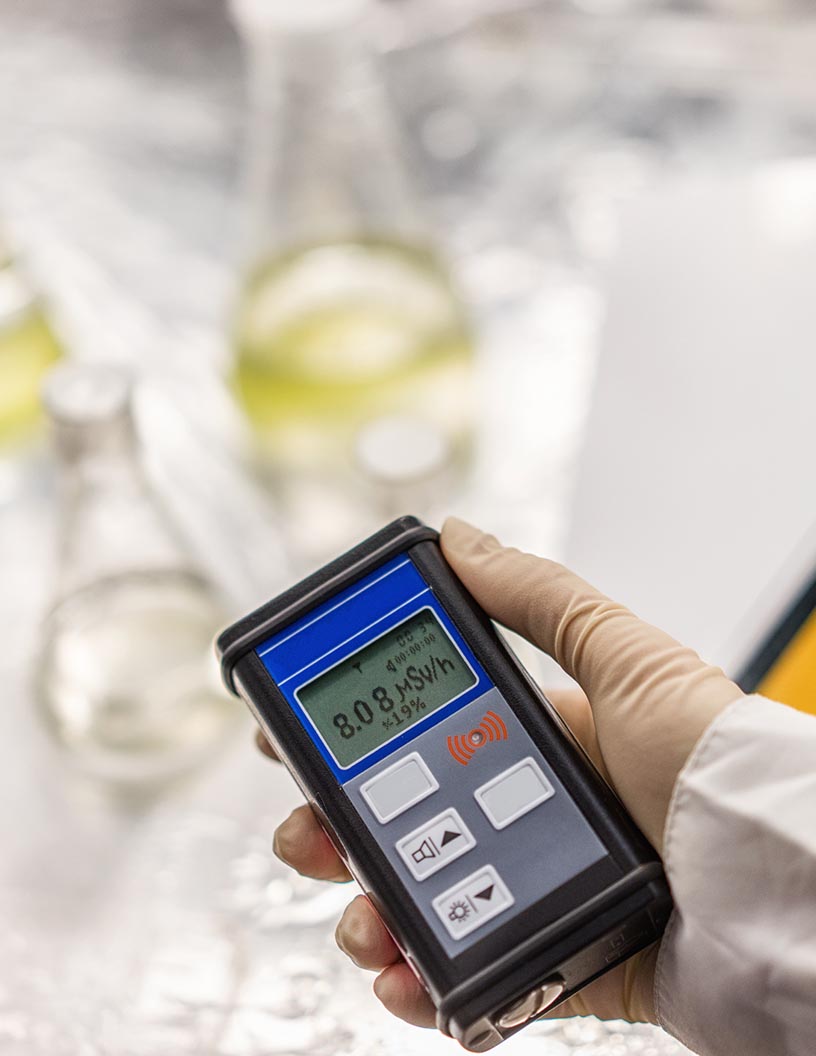






![]() Get the report (PDF) sent to your email within minutes.
Get the report (PDF) sent to your email within minutes.
Complimentary full Excel data with your report purchase.